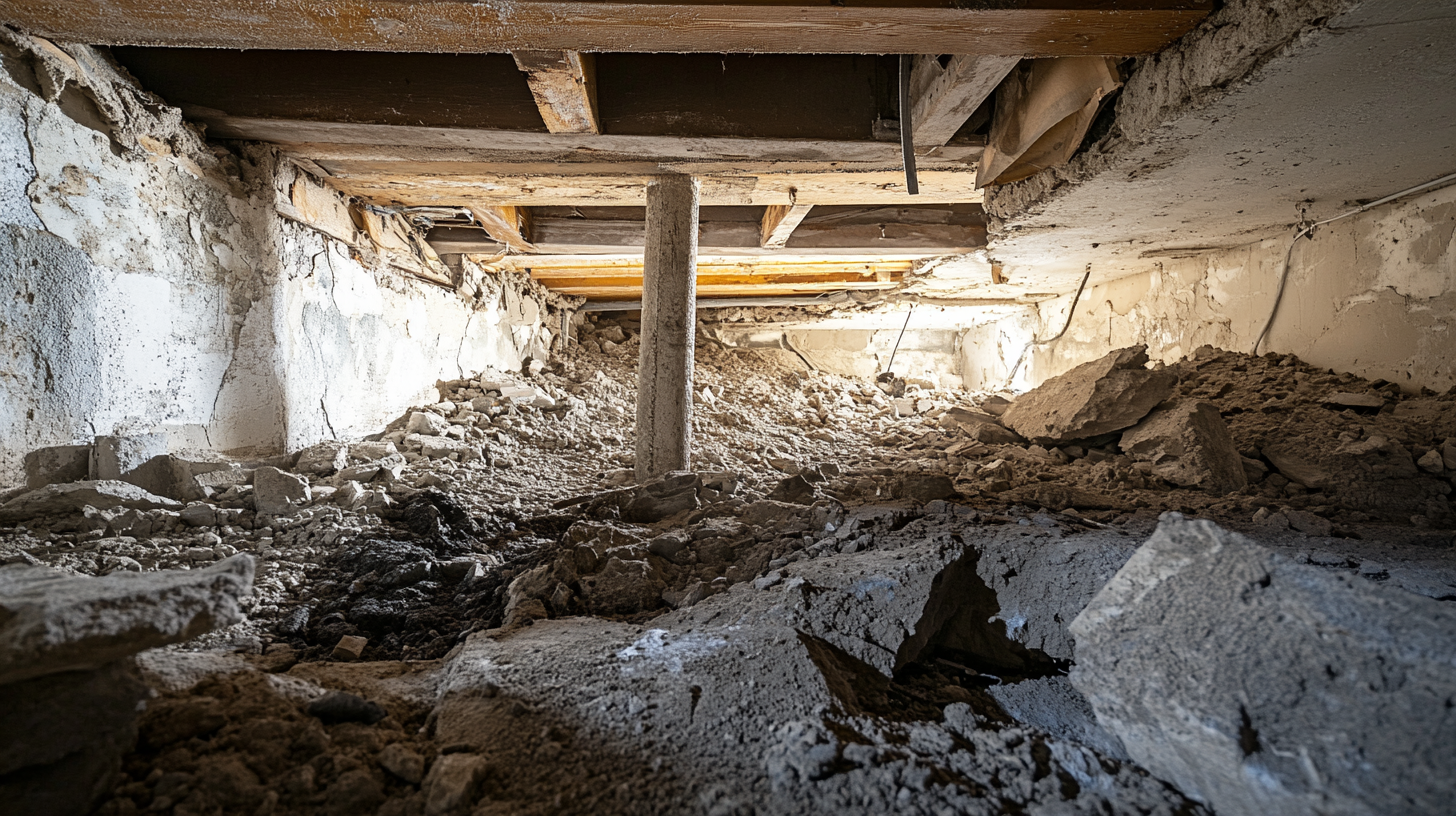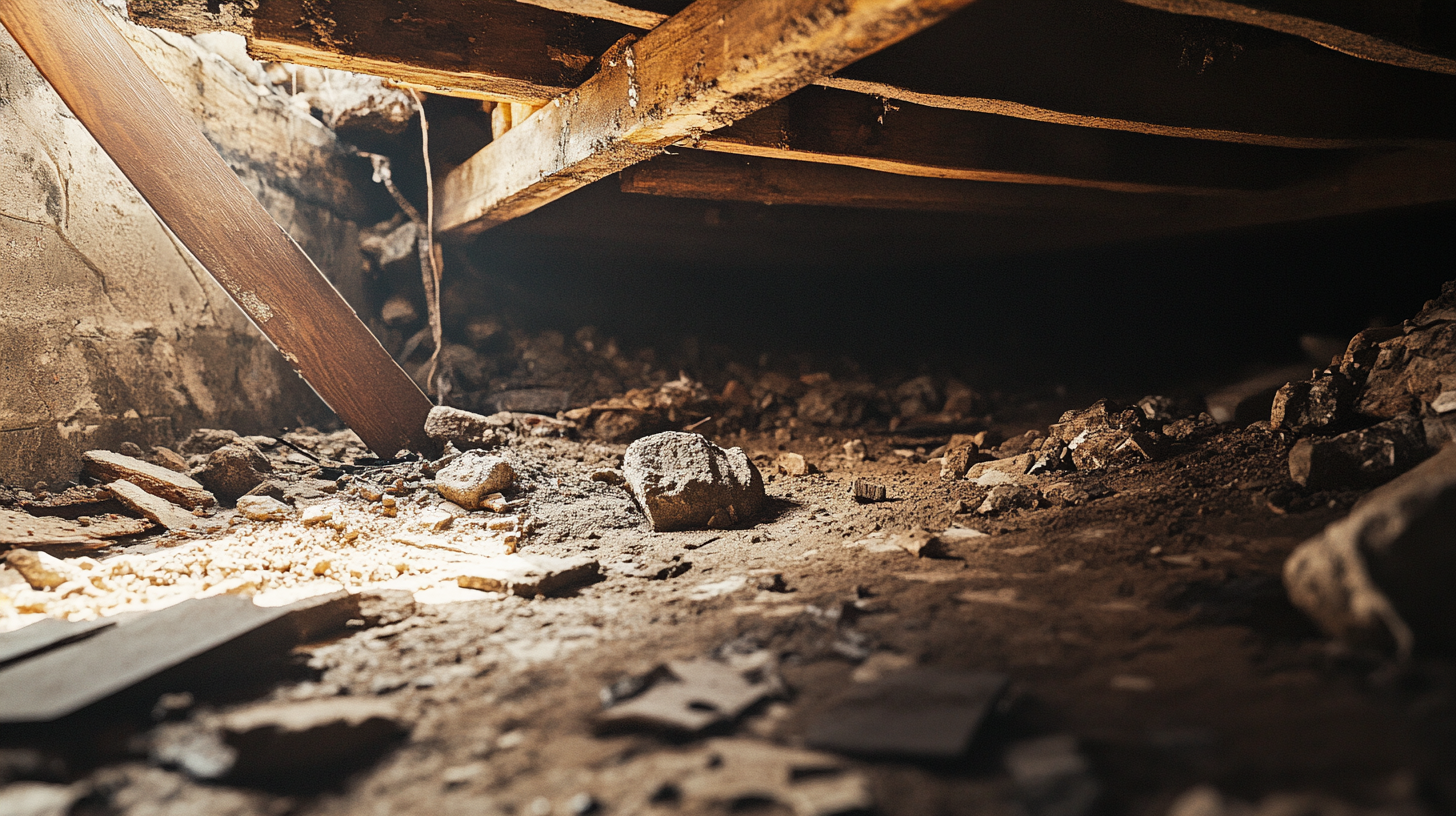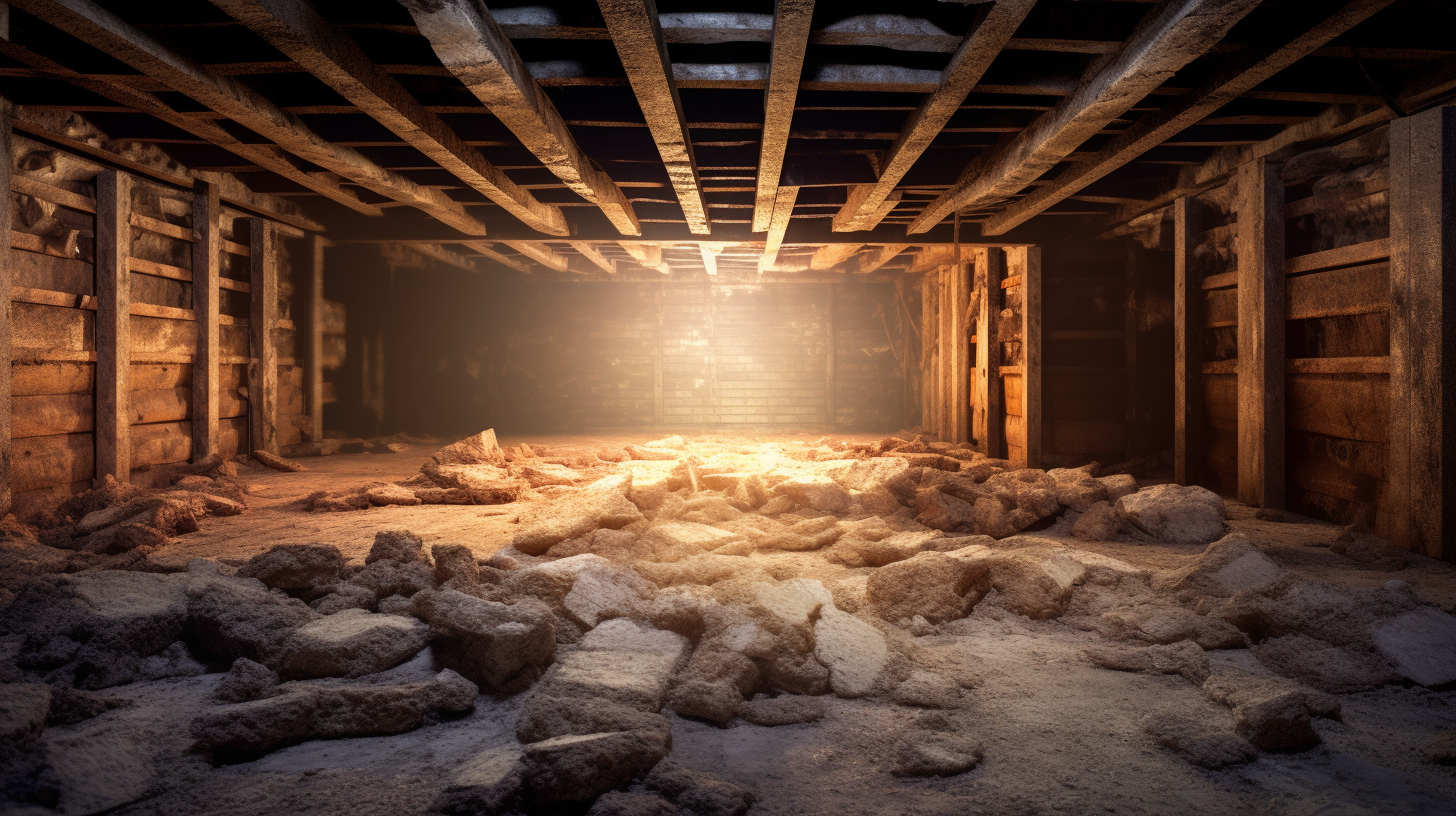In the hidden recesses beneath our homes, a silent battle is waged against an unseen foe: mold. This battle's front lines are often found in one of the most overlooked areas of residential construction—the crawl space. The key to victory in this ongoing struggle lies in understanding and optimizing the relationship between crawl space ventilation and mold prevention. This blog delves into the critical dynamics of this relationship, shedding light on how proper ventilation can be a homeowner's strongest ally in maintaining a healthy, mold-free home.
Mold thrives in damp, stagnant environments, making poorly ventilated crawl spaces its ideal breeding ground. Left unchecked, mold can not only cause significant damage to the structural components of a home but also pose serious health risks to its inhabitants. The stakes are high, and the need for effective crawl space ventilation cannot be overstated.
Through this exploration, we aim to equip homeowners with the knowledge and tools necessary to prevent mold growth by ensuring their crawl spaces are properly ventilated. From the science of mold proliferation to practical tips for enhancing airflow and reducing moisture, this blog will guide you through everything you need to know to protect your home and your health from the dangers of mold.
Join us as we navigate the complexities of crawl space ventilation and mold prevention, offering expert insights and actionable advice. Whether you're battling an existing mold problem or looking to safeguard your home against future issues, understanding the critical role of crawl space ventilation is the first step towards a healthier, more resilient living environment.
The Basics of Crawl Space Ventilation
Understanding the basics of crawl space ventilation is essential for maintaining the structural integrity of your home, ensuring good indoor air quality, and enhancing energy efficiency. This segment explores the critical role of crawl space ventilation and delves into the comparison between traditional and modern ventilation methods, highlighting their respective impacts on a home's moisture levels and energy consumption.
Purpose of Crawl Space Ventilation
Role in Moisture Control and Air Quality:
Crawl space ventilation serves two primary purposes: controlling moisture levels and improving air quality. Moisture accumulation in crawl spaces can lead to mold growth, wood rot, and attract pests, which not only compromise the structural integrity of your home but can also impact the health of its occupants. Proper ventilation ensures that moist air is expelled from the crawl space, replaced by drier air from the outside, thereby reducing the risk of moisture-related issues.
Additionally, ventilating the crawl space helps in mitigating the risk of indoor air pollutants, such as radon gas, volatile organic compounds (VOCs), and mold spores, from rising into the living spaces above. By promoting airflow, ventilation systems help in diluting and removing these pollutants, contributing to a healthier indoor environment.
Traditional Ventilation vs. Modern Solutions
Overview of Different Ventilation Methods and Their Energy Implications:
- Traditional Ventilation: Traditionally, crawl spaces have been ventilated with passive vents that allow air to flow naturally in and out of the space. While cost-effective and simple to implement, passive ventilation can be inefficient, especially in regions with high humidity levels, as it can introduce more moist air into the crawl space. Additionally, in colder climates, traditional venting can lead to increased heating costs as warm air escapes and cold air enters the crawl space.
- Modern Solutions: Modern ventilation strategies include the use of active ventilation systems, such as exhaust fans and dehumidifiers, which can more effectively control moisture levels regardless of external weather conditions. Encapsulation, another modern approach, involves sealing the crawl space and using a dehumidifier to maintain dry conditions. These solutions can significantly improve energy efficiency by stabilizing temperature and humidity levels, reducing the strain on heating and cooling systems.
Modern solutions, while initially more costly to install, can offer long-term savings by preventing moisture damage and enhancing the overall energy efficiency of your home. Choosing the right ventilation method depends on various factors, including your home's geographic location, local climate, and specific moisture challenges.
Impact of Ventilation on Home Energy Use
Proper ventilation plays a pivotal role in maintaining a comfortable and healthy living environment. However, its impact on home energy use cannot be overlooked. By understanding how ventilation influences heating and cooling costs and finding the right balance between ventilation and insulation, homeowners can enhance their home's energy efficiency, reduce energy consumption, and lower utility bills.
Ventilation and Heating/Cooling Costs
How Improper Ventilation Can Lead to Increased Energy Consumption:
Improper ventilation can significantly affect a home's energy consumption, particularly in terms of heating and cooling costs. Inadequate ventilation leads to poor air circulation, which can cause humidity levels to rise in the summer and drop in the winter. High humidity in the warmer months can make the air feel warmer than it actually is, prompting an increased reliance on air conditioning. Conversely, low humidity during colder months can make the air feel cooler, leading to higher heating demands.
- Summer Concerns: Without proper ventilation, homes can become excessively humid and warm, causing air conditioning systems to work harder and longer to remove the moisture and cool down the indoor air, thereby increasing energy consumption.
- Winter Challenges: In winter, inadequate ventilation can lead to stale, dry air, forcing heating systems to operate more frequently to maintain comfortable indoor temperatures, which also increases energy usage.
The Balance Between Ventilation and Insulation
Finding the Right Balance for Optimal Energy Efficiency:
Achieving optimal energy efficiency requires a delicate balance between ventilation and insulation. While ventilation is necessary for air quality and moisture control, insulation helps to maintain a stable indoor temperature by reducing heat loss in the winter and heat gain in the summer.
- Effective Insulation: Proper insulation in walls, attics, and crawl spaces can significantly reduce the amount of energy required to heat or cool a home. However, insulation must be complemented by adequate ventilation to prevent moisture accumulation and ensure good indoor air quality.
- Strategic Ventilation: Ventilation strategies should be designed to provide fresh air and moisture control without compromising the home's thermal envelope. This can include the use of energy recovery ventilation systems (ERVs) or heat recovery ventilators (HRVs), which help to maintain energy efficiency by recovering heat from outgoing stale air and transferring it to incoming fresh air in the winter, and vice versa in the summer.
Finding the right balance between ventilation and insulation is key to maximizing a home's energy efficiency. This balance helps to ensure that heating and cooling systems operate as efficiently as possible, reducing energy consumption and lowering utility costs, all while maintaining a comfortable and healthy indoor environment.
Energy-Efficient Ventilation Strategies
As homeowners increasingly prioritize energy efficiency both to reduce environmental impact and lower utility costs, understanding how to optimize home ventilation becomes crucial. This guide explores strategic choices in ventilation systems and highlights innovative technologies designed to provide fresh air without compromising energy efficiency.
Choosing the Right Ventilation System
Factors to Consider for Energy-Efficient Ventilation:
Selecting the most appropriate ventilation system for your home requires careful consideration of several key factors. These considerations ensure that the chosen system not only improves air quality but also contributes to the home's overall energy efficiency.
- Size of the Home: The size and volume of your home determine the capacity of the ventilation system needed to effectively circulate air throughout the space.
- Climate: Your local climate has a significant impact on the type of ventilation system that will work best. Homes in humid climates may benefit from systems that emphasize moisture control, while those in colder regions might prioritize heat retention.
- Home Layout: The layout of your home, including the number and location of rooms, windows, and doors, affects how air naturally circulates and should influence the type and placement of ventilation systems.
Understanding these factors helps homeowners choose a ventilation system that aligns with their specific needs, ensuring effective air circulation and moisture control while minimizing energy consumption.
Innovative Ventilation Technologies
Introduction to Energy-Efficient Systems:
Advancements in ventilation technology have led to the development of systems that not only ensure a steady flow of fresh air but also recover energy from the exhaust air stream, significantly enhancing energy efficiency.
- Heat Recovery Ventilators (HRVs): HRVs are designed to conserve energy in cooler climates by recovering heat from exhaust air and using it to warm incoming fresh air. This process reduces the energy required to heat new air to a comfortable temperature, saving on heating costs.
- Energy Recovery Ventilators (ERVs): Similar to HRVs, ERVs are used in both heating and cooling seasons but are particularly effective in humid climates. ERVs transfer moisture along with heat between the incoming and outgoing airstreams, helping to maintain comfortable humidity levels indoors without overburdening the HVAC system.
Both HRVs and ERVs represent a significant leap forward in ventilation technology, offering homeowners a way to improve indoor air quality and comfort while reducing energy use and lowering utility bills. By incorporating these systems, homeowners can achieve a balance between fresh air and energy efficiency, making them an ideal choice for those looking to enhance their home's environmental and economic performance.
Enhancing Energy Efficiency with Smart Ventilation
In the modern quest for more sustainable living and energy efficiency, smart home technology plays a pivotal role, particularly in the realm of home ventilation. Smart ventilation systems, including smart vents, offer a sophisticated approach to managing indoor air quality and temperature, leading to significant energy savings and improved comfort. This guide delves into how smart vents operate within the ecosystem of home automation to optimize energy use and enhance the living environment.
The Role of Smart Vents
How Smart Vents Work and Their Benefits for Energy Conservation:
Smart vents are innovative components of a home's HVAC system that automatically adjust airflow to different rooms based on real-time needs, promoting more efficient heating, cooling, and ventilation. Equipped with sensors and connected to a central control system, smart vents can open or close to regulate the temperature in specific areas of the home, a practice known as zoned heating and cooling.
- Energy Conservation: By directing airflow only to rooms that need it, smart vents reduce the energy wasted on heating or cooling unoccupied spaces. This targeted approach can lead to substantial energy savings and lower utility bills.
- Improved Comfort: Smart vents help maintain consistent temperatures throughout the home, addressing common issues such as hot or cold spots in certain rooms, thereby enhancing overall comfort.
- Enhanced Air Quality: Some smart vent systems are designed to monitor air quality and adjust ventilation accordingly, ensuring that indoor air is fresh and healthy.
Integration with Home Automation Systems
Managing Ventilation Efficiently Through Home Automation:
The true potential of smart vents is unlocked when they are integrated into a broader home automation system. This integration allows for seamless control over the home's climate and air quality, often through a single interface such as a smartphone app.
- Automated Adjustments: Home automation systems can automatically adjust smart vents based on various factors, including time of day, occupancy, and even outdoor weather conditions, optimizing energy use without requiring manual intervention.
- Remote Control: Homeowners can manually override automated settings and adjust ventilation remotely, providing flexibility and control no matter where they are.
- System Integration: Smart vents can work in concert with other smart home devices, such as thermostats and air quality monitors, to create a comprehensive environment management system that maximizes energy efficiency and comfort.
By leveraging the capabilities of smart vents and integrating them with home automation systems, homeowners can achieve a new level of energy efficiency and comfort. This smart approach to ventilation not only conserves energy but also contributes to a more sustainable and personalized living environment.
Additional Tips for Energy-Efficient Crawl Spaces
Creating an energy-efficient crawl space is a multifaceted approach that extends beyond proper ventilation. It involves ensuring adequate insulation and conducting regular maintenance to optimize the space's energy use. These strategies not only enhance the overall energy efficiency of your home but also contribute to a healthier living environment and can lead to significant savings on utility bills.
Proper Insulation Techniques
Importance of Insulation in Conjunction with Ventilation:
Insulation plays a critical role in maintaining an energy-efficient crawl space. It works hand in hand with ventilation to regulate the temperature and moisture levels within the space, preventing the transfer of extreme temperatures into the home and reducing the workload on heating and cooling systems.
- Types of Insulation: Various insulation materials can be used in crawl spaces, including fiberglass batts, foam board, and spray foam. The choice of insulation depends on the specific needs of the space, such as moisture resistance and R-value (a measure of thermal resistance).
- Installation Considerations: Proper installation is crucial to maximize the effectiveness of insulation. This includes sealing all gaps and ensuring that the insulation covers the entire area without any compression or gaps. Vapor barriers may also be installed on the ground floor of the crawl space to prevent moisture from rising into the insulated area.
- Energy Efficiency Benefits: Well-insulated crawl spaces help maintain a stable temperature within the home, reducing the energy required for heating and cooling. This not only lowers energy consumption but also enhances the comfort of the living spaces above.
Regular Maintenance and Upkeep
How Routine Checks Can Prevent Energy Wastage:
Regular maintenance and upkeep of your crawl space are essential to ensure its continued energy efficiency. Routine checks can identify and address issues before they lead to significant energy wastage.
- Inspection Schedule: Homeowners should conduct regular inspections of their crawl spaces, looking for signs of moisture accumulation, pest infestation, or damage to insulation and vapor barriers. These inspections can be done seasonally or at least once a year.
- Moisture Control: Keeping the crawl space dry is vital to prevent mold growth and insulation damage. This may involve checking for leaks, ensuring proper drainage around the foundation, and maintaining sump pumps or dehumidifiers if necessary.
- Ventilation System Checks: Regularly inspect and clean vents and fans to ensure they are free from blockages and functioning correctly. This helps maintain effective airflow and moisture control.
By implementing proper insulation techniques and committing to regular maintenance and upkeep, homeowners can significantly enhance the energy efficiency of their crawl spaces. These practices not only contribute to a more sustainable and cost-effective home but also protect the structural integrity and indoor air quality of the living environment.
FAQs
Contact Trench Guys Today!
Trench Guys will do everything we can to ensure your experience with us is excellent.
Request A FREE Estimate
Request a Free Estimate Form
Checkout Recent Post




Got a Question? We’re Here to Help.
You can arrange an appointment or make an enquiry by phone or email, orget in touch to us via our contact form.



